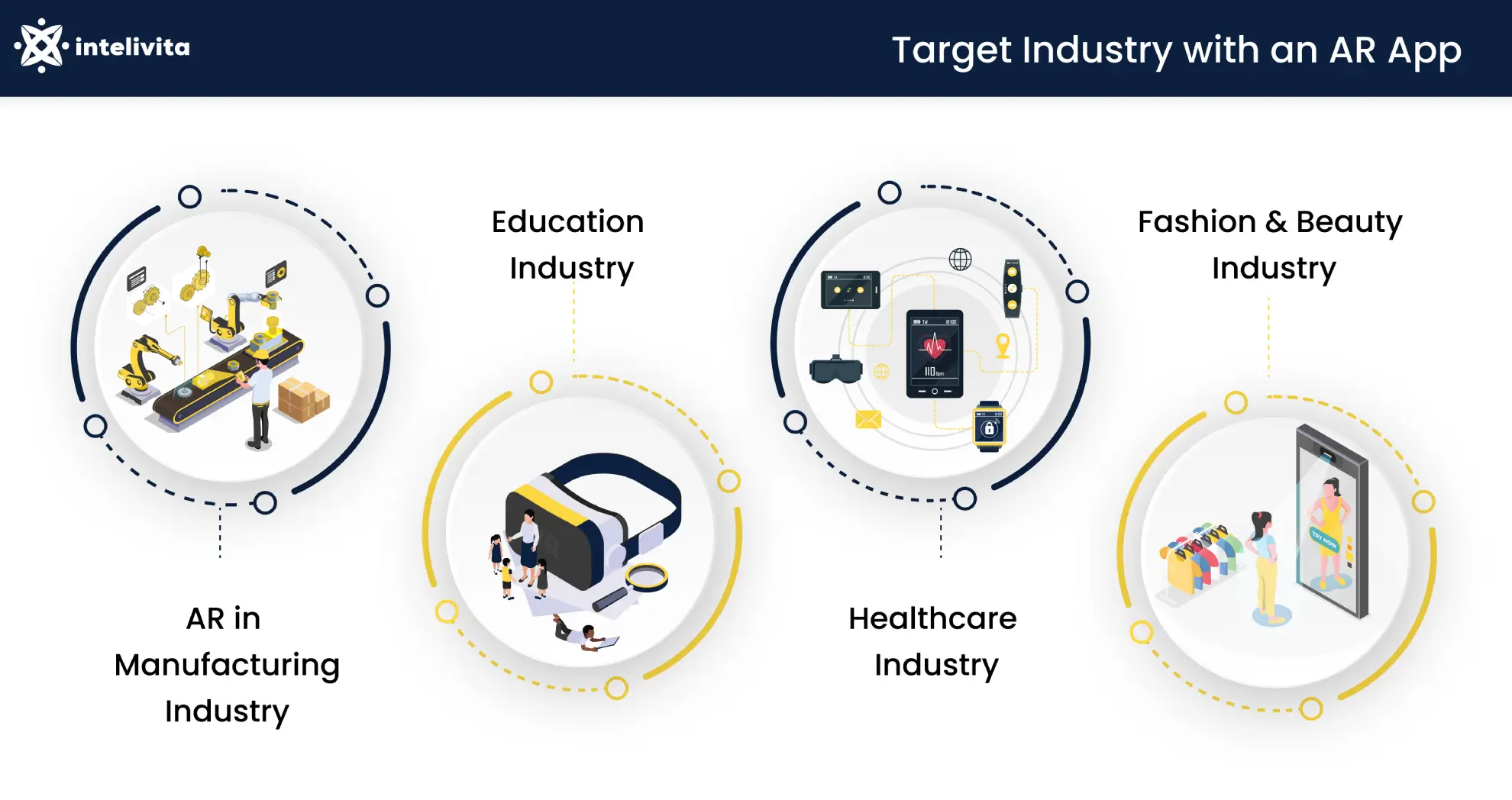Is developing an Augmented Reality app worth the investment?
Being a business, if you are having this question in mind, you should know the statistics of the AR apps.
According to Statista, the number of mobile augmented reality (AR) users are rapidly increasing from the year 2019 to 2024.
In 2019, the number of users was around 0.44 billion which is expected to increase by 1.73 billion in the year 2024.
These statistics clearly show the strong growth in mobile Augmented reality.
But, the question comes to how much augmented reality app development costs. Since it is a matter of precision and quality, we ensure that we do not underperform and do research and curate this guide to answer your question.
How Much Does It Cost To Build An Augmented Reality App?
The total AR app cost ranges from $10,000 to $200,000.
The cost depends upon the requirement of your mobile app, timeline, and complexity.
Also, if you are planning to develop an AR feature-rich mobile app with a custom algorithm and API then the cost will increase.
Craft a tailor-made, data-driven and futuristic AR app that captures the imagination of modern-day users by partnering for Augmented Reality development services.
We’re one of the top AR solution providers; Connect with our industry experts to access premium quality AR products.
Complexity-wise Cost of AR App Development
If you are still in doubt regarding how much augmented reality costs, check the following table. It consists of the AR app type and its approximate app development cost.
| App Complexity | Average Cost |
| Simple AR Application | $10,000 to $50,000 |
| Medium-sized AR Applications | $50,000 to $200,000 |
| Complex AR Applications | $250,000 to $800,000 |
Region-wise AR App Development Cost
Region plays a substantial role in determining the app development cost. Therefore, you should be well aware of each hour of each region.
| Region | Cost ($/hour) |
| North America | $60 to $275 |
| Australia | $55 to $150 |
| UK | $35 to $170 |
| South America | $45 to $150 |
| Central Europe | $22 to $160 |
| India | $10 to $120 |
You have checked the phase-wise cost of building an AR mobile app. Next, learn the category wise AR app development benefits, examples, and cost.
| Category-wise AR App Development Price | |
| AR Apps | AR apps are software programs that incorporate digital audiovisual content into the user’s environment in the real world. |
| Features of AR Apps |
|
| Examples |
|
| Cost | $10,000 to $200,000 |
The following table shows the prime factors which affect the cost of app development.
| Factors that Affect Cost of AR App Development | Description |
|---|---|
| Scope of Work | It depends on the complexity of the app’s logic as well as the amount of required project management and QA labor. |
| Timeline | Rush means a rise in costs, the tighter the deadline, the more expensive the cost. |
| Development Team | The cost varies depending upon developers’ experience and technology. The cost will increase depending upon the developer’s experience and the implemented technology. |
| Geo-location | Developer or company’s geo-location matters a lot when it comes to deciding the cost of an AR app. In North America, the hourly cost ranges from $150/hr, whereas in India the hourly cost is $10 to $80/hr. |
Formula to Calculate AR App Development Cost
Use the following formula to accurately calculate the cost of AR app development.
Let’s understand this formula in detail.
- Time Required to Develop an AR App = Here you need to add the total time required, it will take to develop an app. For example, it will take around 250 hours to develop the app.
- Developer’s Hourly Charge = Next, add the developer’s hourly charge, let’s take $50 per hour.
The amount you need to pay is – 250 hours x $50/hour = $12,500
The total cost can go up to $12,500. You can calculate the app development price accordingly.
Share your AR app requirement with our AR app development consultant and turn your idea into a live mobile app.
How Does Augmented Reality Work?
Augmented reality focuses on devices with cameras integrated into it such as smartphones, tablets, or smart glasses integrated with AR software.
To activate the AR, you just need to point the device to a specific object, as soon as the software detects it via computer vision technology, analyzing the video stream as well.
To help you to understand how AR works, go through this 3 step process.
- The gadget stores the user’s environment with tools such as a camera and sensors
- The software gathers and processes data to decide the location of AR objects.
- After processing this, the object of AR generates in real-time
The following mediums are also used by AR to collect users’ surroundings in addition to smartphone devices.
- Depth sensors
- Accelerometers
- Cameras
- Gyroscopes
- Light sensors
Is Making Augmented Reality App Beneficial?
Prior to discussing whether to develop an AR app or not, let’s look at the recent statistics on mobile AR. By the year 2024, it has been estimated that around 1.7 billion mobile AR devices will be seen across the globe. A rise of 1.5 billion from the 200 million in 2015. These statistics clearly show the sign of growth in the AR industry.
Now coming to the point, yes, building an AR app will help you to gain significant advantages for your business by creating unique digital experiences.
One of the most significant benefits of augmented reality is that AR apps increase user engagement and in turn directly help you to increase revenue in your business. We have discussed each benefit comprehensively in the following table, have a look.
| Benefits of AR App Development | Description |
| Helping create a unique client experience | One of the best things about AR is that it combines physical and digital experiences. Also, it doesn’t require additional software or hardware to savor the experience. The best example is Pokemon Go, experiencing the entire Pokemon universe on your phone. |
| Make work quicker and more accurate | Industries require AR applications to make their work faster and error-free. |
| Remove cognitive overload | AR makes it unnecessary to retain vast amounts of information. AR apps will enable you to make rapid decisions without being overburdened with information rather than consulting the complete manual. |
Example of AR App in Education
AR application helps students to understand complex mathematical concepts via interactive 3D models and visualization.
If we can take an example of a Merge Cube, it allows students to hold, view and rotate a virtual cube by allowing them to learn complex concepts of geometry in an interactive way.
You have learned about the benefits of building AR apps, but which industry should you target to get the maximum gains? The answer lies in the next section.
Which Industry Could You Target With an Augmented Reality App?
1. Integrating AR in Manufacturing Industry
Mistakes have no place in the manufacturing industry. The entire development process should be error-free. Even a minor issue in manufacturing may cause the reason to rebuild the existing product which may consume a lot of time and cost.
The study conducted by the University of Patras mentions that AR interfaces can enhance and blend into the workplace, making interactions with [robots] simple and natural.
How does AR Benefit Manufacturing Industry?
- By integrating factories with augmented reality, data, and complex problem-solving boosts productivity as well as efficiency in the business.
- AR offers an excellent solution by easily spotting minor manufacturing errors.
- AR makes it easier to understand the prototype by converting it to 3D, helping business leaders to make decisions effectively.
- By offering 3D modules to almost every prototype AR increases efficiency rating, which increases the user experience and business profit.
2. Education Industry
AR in the education industry is consistently scaling at a faster pace. According to leading market research and competitive intelligence providers, the global AR education market is predicted to reach $80 billion by the year 2031.
AR is helping to address issues by offering natural content and permits to choose subjects based on student selection. Let’s look at how AR is beneficial to the education industry.
How does AR Benefit the Education Industry?
- AR offers visual representations, by helping students to process, and remember information accurately.
- AR offers a contemporary method of education by including audio, video, and games to make learning more fun and interesting.
- AR has revolutionised corporate training and development by consistently bringing innovative technologies.
3. Healthcare Industry
AR is redefining the healthcare industry by allowing the use of connected devices and making computer integration easier with computer vision and artificial intelligence. If we look at the growth, the market for AR in healthcare was valued at $609.60 million in 2018 and is anticipated to grow to $4,237.60 million by 2026, at a CAGR of 27.4%.
There are multiple ways AR directly or indirectly benefits the healthcare industry. The following section talks about the critical benefits of AR in the healthcare industry.
How does the AR Benefit Healthcare Industry?
Pharmaceutical companies have begun using 3D heart modelling software to show how medicine moves through the organ and what effects it has during a treatment. As a result, it is simpler for the patients to understand the science underlying how AR works.
Launching new goods is the area where AR has the biggest influence for life sciences companies, especially as companies deliver more sophisticated therapies and combo medical devices to patients.
4. Fashion and Beauty Industry
According to Global Market Estimates, the beauty, and fashion industry is about to grow at a CAGR value of 25.5% from the year 2022 to 2027. From personal care products to super premium business brands, all the businesses are driving growth throughout this period.
To offer users a store-like environment, AR offers a physical retail store-like environment.
Get in touch with us to uncover cost-effective strategies for AR development that ensure optimal results without breaking the bank.
Apart from that, the prime reason for the growth in the fashion and beauty industry is augmented reality regulation and modification like reality and aesthetics to increase demand among female consumers.
How does AR Benefit the Fashion and Beauty Industry?
- AR tools allow makeup and other cosmetic products to consumers safely and in a contactless way.
- AR has removed the guesswork from the products by increasing users’ purchasing confidence. For example, using AR users can directly determine which makeup color they would like to choose and see themselves trying virtually.
We have discussed the growth of different industries using AR technology and how they benefit from it. Next, check the list of points to consider while developing an AR app.
Things to Consider for Building Augmented Reality App
Decided to build an AR app but are not sure where to start? Here are 4 crucial points for you to consider.
1. Select the Right AR App Development Tools
The following table consists of the best AR app development tools, ratings, features, and platform support helping you to make the app development process seamless.
| Tools | Ratings (G2) | Features | Platform Support |
| Vuforia | 4.2/5 (52 Reviews) |
|
|
| ARKit | 4.3/5 (71 Reviews) |
|
|
| RealityKit | 4.2/5 (13 Reviews) |
|
|
2. Perform In-depth Market Research
Performing through market research will help you to clear out many doubts in your app development stage.
Here are some of the steps you can follow to perform better market research.
- Check the similar application in Google Play Store, and App Store. Download similar mobile apps to check features and create a list where you can improve.
- Check UI/UX, performance, and features of different AR applications, so that you can offer an excellent app experience to users.
3. Set Your Requirements In-line
After performing market research, the next step is to gather requirements.
Check the following requirements to consider for app development.
- Features that you want to include
- The type of mobile app you want to create from native, hybrid,
- Choose the app development platform from iOS, Android, and AR platforms.
4. Define the Proper Development Process
Decide whether you want to hire an AR app development company or a team of AR app developers for your project. Once decided, share your requirements with them and finalize the cost.
Ensure that you have clarified doubts with the team before initiating the development. Make sure to keep the centralized communication channel to avoid confusion.
We have discussed the development process of AR, next learn the types of AR applications.
Types of Augmented Reality Applications
The following table shows the 5 different types of AR applications:
| Types of AR Application | Features of AR Application |
|---|---|
| Projection-based AR |
|
| Marker-based AR |
|
| Markerless AR |
|
| Location-based AR |
|
| Superimposition AR |
|
After discussing cost, development steps, and types, next, we have answered some of the important questions related to AR app development.
Frequently Asked Questions
How to Choose an AR App Development Company?
Here are the top factors to consider while choosing an AR app development company.
| Factors to Choose | Description |
| Portfolio | Check the company’s portfolio section and whether they have built a similar solution you are looking to build. |
| Cost Estimation | AR app development cost differs from company to company. Even the cost increases and decreases depending upon the geo-location as well |
| Technological Expertise | The company you select should be proficient in building AR apps with the latest tools and deliver the authentic experience you wish to receive. |
How Much Time Does it Take to Develop a Basic AR App?
It takes around 100 to 150 hours to build a marker-based AR mobile app.
However, the timeline to build an AR app depends on the complexity of the app, the expertise of the developer, as well as the team size.
Also, after developing each module, it is crucial to test it thoroughly before moving ahead with the next module. This process takes 8 to 10 hours (depending on the size and complexity of the module as well).
Conclusion
In this guide we have discussed the cost of building augmented reality apps for different types of AR apps to make sure you don’t miss out on anything while planning for AR app development.
Apart from these points, we have answered important questions such as app development factors and timeline to clear your doubts.
Intelivita is a prominent AR app development company having a team of over 12 experience AR app development professionals.
Our portfolio consists of building more than 25 AR applications.



![AR In Real Estate [A Complete Guide Along With Examples]](https://www.intelivita.com/wp-content/uploads/2023/12/AR-In-Real-Estate-A-Complete-Guide-Along-With-Examples.webp)

![Augmented Reality (AR) In Remote Collaboration [Benefits]](https://www.intelivita.com/wp-content/uploads/2023/11/Augmented-Reality-AR-In-Remote-Collaboration-Benefits.webp)

